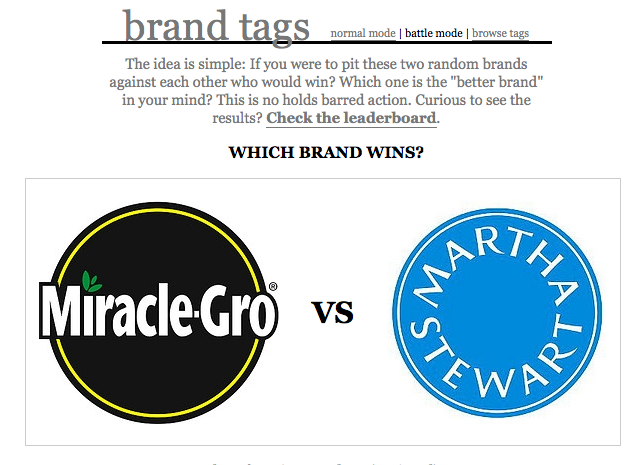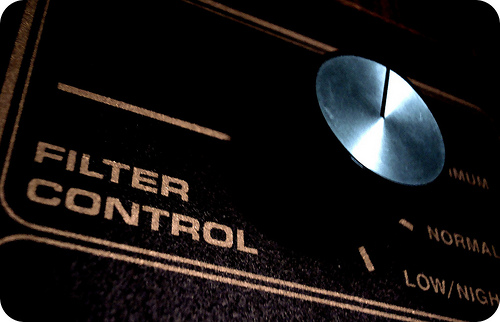Who controls the meaning of your brand on the internet?

One of the principles of the assembled web says:
Your brand is not what you say it is, but what your prospects, customers, partners, and employees say it is. In short, your brand is what the Internet says it is. You influence this not through marketing but through creating appropriate experiences and getting users exposed to those positive experiences. (Micro-interactions are ultimately assembled into and become brands).
One site which demonstrates this quite well is Noah Brier‘s Brand Tags which presents the user with a brand and asks for a one word (or phrase) tag. The results for BBC, for example, include (in descending order of priority):
news, british, tv, quality, england, television, reliable, english, smart, bbc, boring, radio, top gear, intelligent, serious
Whereas Fox News gets these results (again in descending order of priority):
biased, conservative, news, lies, republican tv, liars, right wing, bias, crap, evil, propaganda, boring, simpsons
Interesting that both end up with “boring,” though I suspect the BBC is happier with its results than Fox News. (Yes, of course, it’s not a fair sample, since the population drawn to Brand Tags may not be representative of the whole population – but that doesn’t mean it isn’t meaningful.)
There’s also a battle mode, in which two brands are presented and the user chooses which “wins”:

Current winners on the leaderboard? Adidas, Google, Pixar, Apple, BMW, Nike, Lego, Coca-Cola, YouTube, and Ferrari make up the top 10.
This week, Seth Godin and Squidoo launched something they call Brands in Public, which is essentially a microsite containing aggregated information about a specific brand from throughout the web, offering the brand owner the opportunity to respond (albeit for a cost). As a starter set, they created 200 “sample pages” for major brands.

Godin claimed the pages offered not exactly control, but an opportunity to influence brand perception:
You can’t control what people are saying about you. What you can do is organize that speech. You can organize it by highlighting the good stuff and rationally responding to the not-so-good stuff. You can organize it by embracing the people who love your brand and challenging them to speak up and share the good word. And you can respond to it in a thoughtful way, leaving a trail that stands up over time.
The Squidoo offering would bring together what users are saying about your brand throughout the web:
If your brand wants to be in charge of developing this page, it will cost you $400 a month. And once [we build] the page, the left hand column belongs to you. You can post responses, highlight blog posts, run contests or quizzes. You can publicly have your say right next to the constant stream of information about your brand (information that’s currently all over the web–and information you can’t “take down” or censor). You can respond, lead and organize. If a crisis hits, your page will be there, ready for you to speak up. If your fans are delighted, your page makes it easy for them to chime in and speak up on sites around the web.
Of course, not all brands were so happy about the fact that Squidoo had created this centralized place to find feedback about them. Meghan Keane of Econsultancy put it the most bluntly (Give Squidoo $400 a month. Or your brand gets it):
Squidoo is providing a forum for brands to monitor, control and influence their reputation online. But rather than letting brands set up their own pages, Squidoo is doing it for them and dangling control over the site for the $400 monthly fee.
If that price sounds like a threat, it is. If Brands in Public becomes a space where people go to learn about brands, it would be in a company’s best interest to influence the way they’re pictured there. It’s up to them to decide if it’s worth paying Squidoo $4800 a year to influencethe way they look in the space.
As a result of the criticism (of which the above was just a single sample), Godin and Squidoo have changed course, and will be only setting up Brand in Public pages for brands which request them. Godin explains:
One way we tried to encourage that was to build 200 sample pages, pages brands could adopt. Alas, some people felt that this was inappropriate, so we’ve recalibrated and we’ll take those pages down before the end of the day.
When a brand wants a page, we’ll build it, they’ll run it and we’ll both have achieved our goals.
So is it band hijacking (taking over control without permission) to set up such a focused page? Isn’t that essentially what all the real time search engines already do, under the radar?
Compare the search results from, for example, Spezify for a brand against what would have been on the Brands in Public page: isn’t the only different the claim to offer some opportunity to respond?
Is the problem rather that the Brands in Public pages offered too little value, in terms of what influence they would enable a brand to exert?
How different is this from the model of Get Satisfaction, which creates a community around given products or services and offers product/service owners the opportunity to participate? (Check, for example, the Nike Community which is actually supported by Zappos not Nike). I don’t believe GetSatisfaction gets permission from brands to enable their products and services to be discussed – is that brandjacking?
How should brands attempt to influence the perception customers, prospects, employees, and partners have of them, and share freely across the web?
3 Comments
Comments are closed.